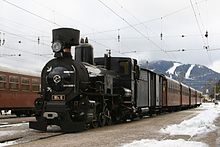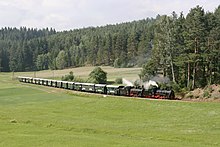NÖLB Mh
| NÖLB Mh / BBÖ Mh / ÖBB 399 / SLB Mh | |
|---|---|
|
399.03 in Alt Nagelberg station, Waldviertel narrow-gauge railways
|
|
| Numbering: | NÖLB Mh 1–6, BBÖ Mh 1–6, ÖBB 399.01–06 SLB Mh 3 NÖVOG Mh 1, Mh 4, Mh 6 |
| Number: | NÖLB: 6 BBÖ: 6 ÖBB: 6 |
| Manufacturer: | Krauss & Comp. / Linz |
| Year of construction (s): | 1906-1908 |
| Axis formula : | D2h2st |
| Gauge : | 760 mm ( Bosnian gauge ) |
| Length over coupling: | 11.665 m |
| Total wheelbase: | 8,100 mm |
| Service mass: | 45.08 t |
| Friction mass: | 30.08 t |
| Top speed: | 40 km / h |
| Driving wheel diameter: | 920 mm |
| Rear wheel diameter: | 660 mm |
| Control type : | Heusinger control |
| Number of cylinders: | 2 |
| Cylinder diameter: | 410 mm |
| Piston stroke: | 450 mm |
| Boiler overpressure: | 13.0 atm |
| Number of heating pipes: | 96/15 |
| Heating pipe length: | 4,100 mm |
| Grate area: | 1.59 m² |
| Radiant heating surface: | 6.52 m² (in contact with fire) |
| Tubular heating surface: | 72.33 m² (in contact with fire) |
| Superheater area : | 22.55 m² (in contact with fire) |
| Evaporation heating surface: | 78.85 m² (in contact with fire) |
| Water supply: | 5.0 m³ |
| Fuel supply: | 1.92 t |
The number Mh of the Lower Austrian State Railways (NÖLB) is a narrow gauge - Supports Locomotive , originally for the mountain section of the Mariazell Railway was constructed.
history
The Niederösterreichische Landesbahnen, which built the Mariazellerbahn and operated it until it was taken over by the BBÖ , initially ordered four superheated steam locomotives (designation Mh.1 to Mh.4) from Krauss in Linz for the mountain route , the 1906 and two composite steam locomotives , which were designated Mv. 1 and Mv.2 and were put into operation in 1907. Since the superheated steam variant proved itself better in operation, two machines of this type were purchased and put into service in 1908 (Mh.5 and Mh.6). These two locomotives were originally equipped with a Kobel chimney as a spark arrester. The designation of the locomotives comes from M as the first letter of Mariazell.
The Mv and Mh series arose out of the need of the NÖLB to have more powerful locomotives available for the Mariazellerbahn, which is currently under construction, than has been customary on the Austrian narrow-gauge railways. B. the U series on the demanding mountain railway soon proved to be underperforming. In order to achieve the highest possible friction weight of 30 tons and to ensure good cornering , a construction with a Krauss support tender was chosen, in contrast to the similar series IVa 5 , a tender locomotive of the Bosnian-Herzegovinian state railways . The model for the basic conception of Mv and Mh were the locomotives of the kkStB series 79 for the Arlbergbahn, also a mountain railway , which had been built twenty years earlier at the Floridsdorf locomotive factory . In contrast to these, however, the narrow-gauge machines proved themselves right away.
However, the high number of passengers made the electrification of the line to Mariazell and Gußwerk necessary after a few years , so that from 1911 the steam locomotives were only used on the branching Ober-Grafendorf – Gresten local railway (the so-called "Krumpe"), where they were more powerful until they were purchased Diesel locomotives of the series 2095 were needed around 1960 for heavy freight trains. As a result, they were also used on other Austrian narrow-gauge railways, e.g. B. the Waldviertel narrow-gauge railways , the Vellachtalbahn in Carinthia and the Pinzgaubahn . From around 1970 the number 399 was concentrated in the Waldviertel, where it handled a large part of the total traffic until the 1980s. As a result, the Waldviertel narrow-gauge railways developed into a popular travel destination for railway enthusiasts from all over Europe. It was not until the Bregenzerwaldbahn was shut down in 1982 that the series 2095 diesel locomotives that had become vacant were due to be replaced in scheduled service, which, however, dragged on until 1986. Even after that, there were still numerous deployments as reserve machines in front of scheduled trains around Gmünd. This only ended when the traffic on the Waldviertel narrow-gauge railways was gradually discontinued until 2001.
After 1938, the Deutsche Reichsbahn classified the Mv as 99 1101–1102 and the Mh as 99 1111–1116. In 1953 the ÖBB renamed the Mh series to 399 and the Mv series to 299.
The two composite locomotives 299.01 and 299.02 were finally shut down in the early 1960s after the appearance of the first new narrow-gauge diesel locomotives of the 2095 series. After the formal retirement in 1973, snow plows were built on their still usable frames; none of them survived. The 399 series locomotives have all been preserved and some of them are ready to run. They are used for nostalgic trips : 399.01 on the Waldviertel narrow-gauge railways , 399.03 on the Pinzgauer local railway (again under their original name Mh.3) and 399.06, since the restoration completed in 1993 under the old name Mh.6, stationed in Ober-Grafendorf the Mariazellerbahn.
The inoperable 399.02 and 04 were parked in Gmünd for a long time. 399.05, which was last in service in 1990, was acquired by a private person after it was retired and sold to the Austrian Society for Railway History in 2009 . An operational refurbishment of the 399.05 is planned.
With the handover of some of the Lower Austrian branch lines to NÖVOG , the 399.01, 399.02, 399.04 and Mh.6 also changed hands. The 399.02 and 04 were initially still in Gmünd as spare parts donors, the 399.01 was in use in 2011 and came to Meiningen in mid-2012 with a boiler damage , from where it returned at the end of May 2013 labeled Mh.1. The 399.02 was sold to Salzburg AG in 2014, where it is located in Zell am See at the Pinzgauer Lokalbahn . The Mh.4 was also refurbished in Meiningen until 2015, returned and successfully completed its load test drive as a train with nine passenger wagons on November 26, 2015. The Mh.6 is also under the NÖVOG on some weekends in the summer months on the Mariazellerbahn and is still looked after by the Mh.6 railway club in Ober-Grafendorf.
Construction principle
The Mh and Mv are support tender locomotives with the axle formula D2, in which the axles of the Krauss support tender are hinged to the main frame of the locomotive and set the last coupling axle. The first coupling axle and the driving axle without flange are fixedly mounted in the frame, while the second and fourth axles have lateral play. This construction enabled an optimal run with arc radii of 80 m. It is driven by a superheated steam twin steam engine . The performance was sufficient to move trains up to 120 t at a speed of 30 km / h over the 27 ‰ steep ramp between Laubenbachmühle and Gösing .
NÖLB series Mv
| NÖLB Mv / BBÖ Mv / ÖBB 299 | |
|---|---|
| Numbering: | NÖLB Mv.1–2, BBÖ Mv.1–2, ÖBB 299.01–02 |
| Number: | NÖLB: 2 BBÖ: 2 ÖBB: 2 |
| Manufacturer: | Krauss / Linz |
| Year of construction (s): | 1907 |
| Retirement: | 1973 |
| Axis formula : | D2n2vst |
| Gauge : | 760 mm ( Bosnian gauge ) |
| Length over coupling: | 11.665 m |
| Total wheelbase: | 8,100 mm |
| Service mass: | 45.08 t |
| Friction mass: | 30.08 t |
| Top speed: | 40 km / h |
| Driving wheel diameter: | 920 mm |
| Rear wheel diameter: | 660 mm |
| Control type : | Heusinger control |
| Number of cylinders: | 2 |
| HD cylinder diameter: | 370 mm |
| LP cylinder diameter: | 550 mm |
| Piston stroke: | 450 mm |
| Boiler overpressure: | 13.0 atm |
| Number of heating pipes: | 166 |
| Heating pipe length: | 4,100 mm |
| Grate area: | 1.59 m² |
| Radiant heating surface: | 6.52 m² (in contact with fire) |
| Tubular heating surface: | 88.52 m² (in contact with fire) |
| Evaporation heating surface: | 95.04 m² (in contact with fire) |
| Water supply: | 5.0 m³ |
| Fuel supply: | 1.92 t |
The locomotives of the type Mv (series 299) have the same construction of the chassis , but due to the different construction of the boiler and the steam engine (compound drive) have partly different technical data than those of the type Mh (series 399).
literature
- Directory of the locomotives, tenders, water cars and railcars of the kk Austrian State Railways and the state-operated private railways as of June 30, 1917 , 14th edition, published by the kk Austrian State Railways, Vienna, 1918
- Horst Felsinger, Walter Schober: The Mariazellerbahn. 3rd, expanded edition. Pospischil, Vienna 2002, weblink .
- Walter Krobot, Josef-Otto Slezak, Hans Sternhart: Schmalspurig durch Österreich 1825–1975 , 4th edition, Verlag Slezak, Vienna, 1991, ISBN 3-85416-095-X
- Hans P. Pawlik: Technology of the Mariazellerbahn . Slezak publishing house, 2001, ISBN 3-85416-189-1
- Heribert Schröpfer: Traction vehicles of Austrian railways - steam locomotives BBÖ and ÖBB , alba, Düsseldorf, 1989, ISBN 3-87094-110-3
- Dieter Zoubek - Preserved steam locomotives in and from Austria, self-published, 2004, ISBN 3-200-00174-7





